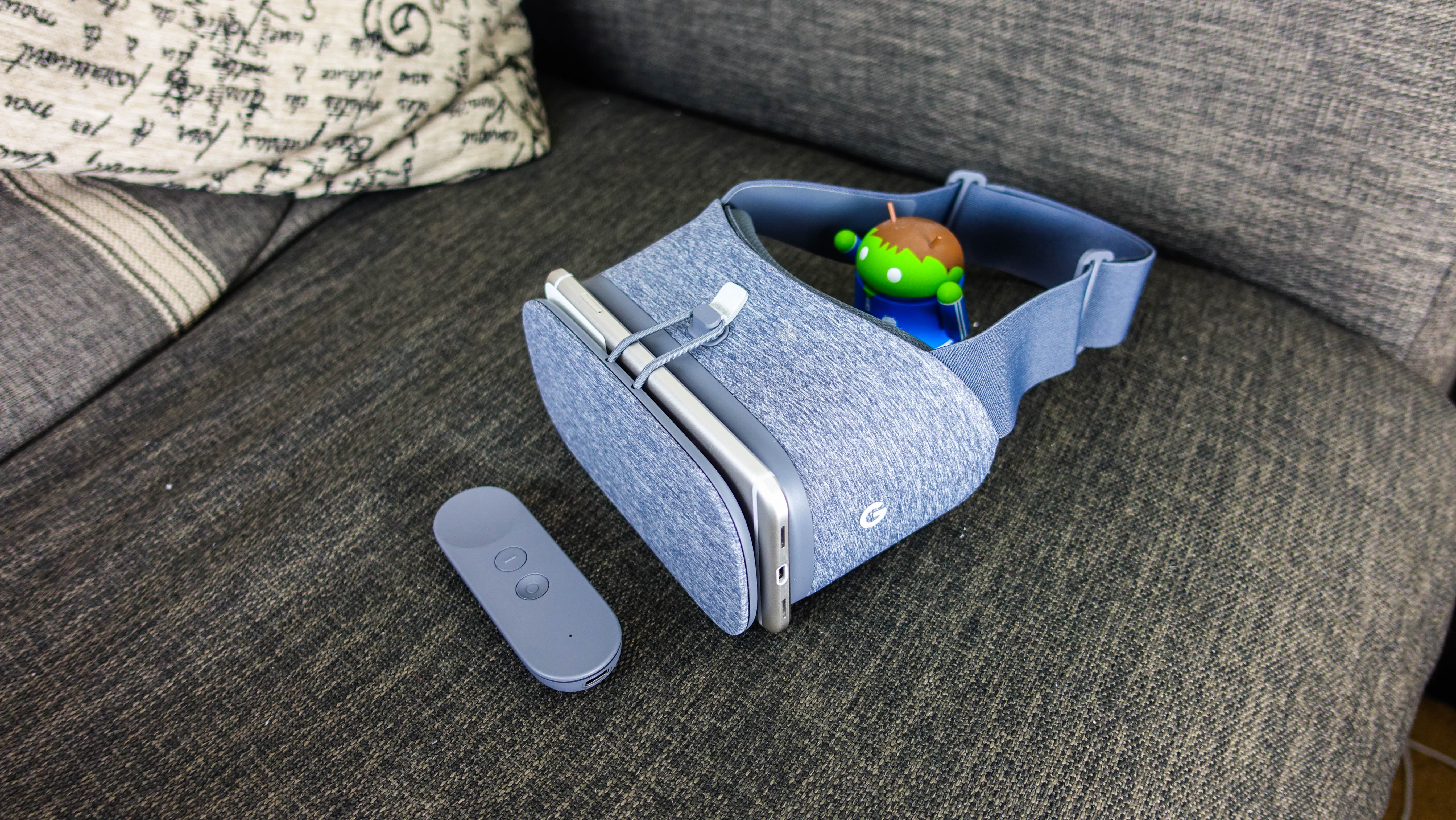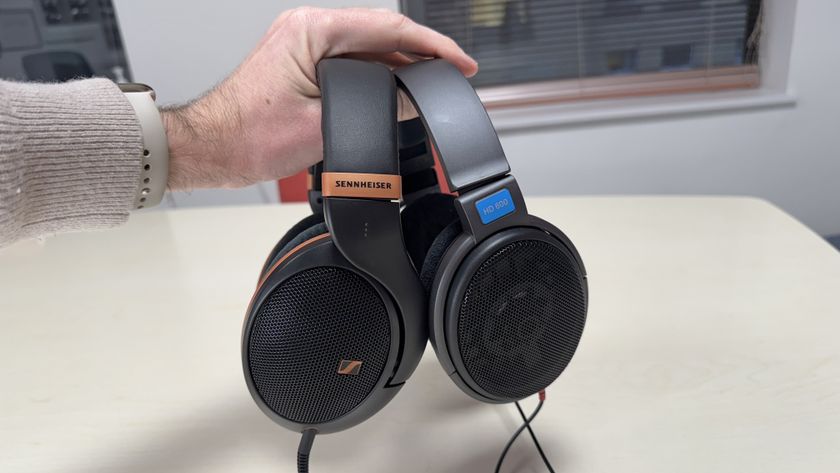TechRadar Verdict
It's easy to get sucked into virtual reality with Google Daydream View. It's poised to work with more Android phones than any other VR platform, and it's very inexpensive. Of course, it needs more engaging content before it's worth purchasing.
Pros
- +
Very inexpensive VR headset
- +
Comes with a remote control
- +
Fabric design and flashy colors
Cons
- -
Content is just getting started
- -
Light bleeding is a problem
- -
Phone runs hot, slows down
Why you can trust TechRadar
Update: Google has announced a refreshed version of the Daydream View (2017) headset, which boasts a streamlined design, new fabric, enhanced optics to widen the field of view and, of course, a few new colors to enjoy.
These improvements come at a cost that's slightly above the first-gen model. $99 (£99, AU$149) will nab you the headset, which comes with a remote as always.
We've tested it out for a hands-on, but will be getting a more in-depth look soon.

Google Daydream View is ready to transform your next Android phone into an immersive virtual reality headset for a convincing price.
It's Google's new mobile-based VR headset for the Google Pixel and Pixel XL, and this one is poised to work with a lot more Android phones in the future.
Daydream View gives you a simple way to experience 360 degree games, videos and panoramic photos if you fasten your phone into its all-fabric headset body.
Perhaps the biggest difference between it and the plastic Samsung Gear VR and Alcatel VR Goggles is the fact that Google emphasizes an included controller.
Right out of the box, we waved around Google Daydream View's tiny remote, and it acted as our essential navigation and gameplay wand.
That beats using Samsung's on-headset buttons for controls. The only proper way to cast Harry Potter-inspired spells or go bowling these days is with a Nintendo Wii-inspired remote.
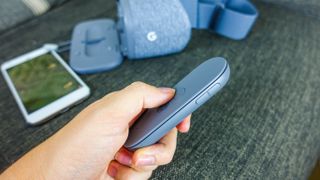
The fabric-coated headset design is also more comfortable than its competitors, though outside light can peek in and the phone's performance can take a hit when overheating. This is no Oculus Rift, HTC Vive or PlayStation VR.
Instead, this is Google's inexpensive roadmap to virtual reality on Android and a Chromecast-like bid to beat everyone else on price and get consumers hooked on its VR foruma.
Let's get immersed to see if it's enough to get you hooked, too.
Price and release date
- $79 in the US
- £69 in the UK
- AU$119 in Australia
- It's $20 (£10, AU$40) cheaper than Gear VR
Google Daydream View is ridiculously inexpensive for a virtual reality headset, at least one you actually want to buy in 2016.
The official release date is today, November 10, and it's $20 (£10, AU$40) cheaper than you'll pay for a new Samsung Gear VR.
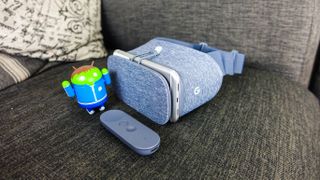
In the US, it costs $79 and is available right now via the Google Store, Best Buy and Verizon. Remember, Verizon is the sole US carrier with the Google Pixel and Pixel XL on contract.
The Google Daydream View UK price is £69, and you can find it at the Google Store, EE and Carphone Warehouse.
Looking for the headset in Australia? It's AU$119 at two retailers right now, either the Google Store or JB Hi-F. Telstra starts selling it on November 22.
Design and comfort
- Fabric design is comfortable and stylish looking
- Eyeglasses fit, but leaves you with red face lines
- Light leaks in from the sides, so turn out your lights
Daydream View is the same size and shape as an average mobile VR headset, but it appears to be covered in our sofa. Seriously.
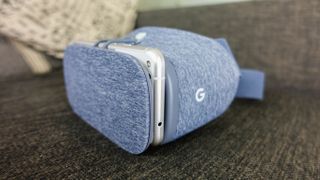
Its distinct fabric layer gives new meaning to Google's 'Material Design' and, like the rather peculiar glass-and-metal Pixel and Pixel XL, it stands out.
It appears to be covered in our sofa. Seriously.
Going with the 'natural' fabric design are three different color choices, Slate and new colors as of December 1, Snow and Crimson – just in case you want to match your favorite sweatpants.
This likable, lightweight material feels comfortable to wear in short bursts and the single elastic band in back holds the headset to your noggin.
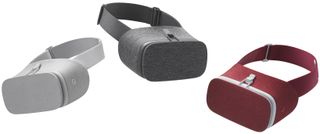
It's surprisingly steady without a top strap, which means it won't mess up your hair, mohawks included. Its eye socket-hugging facepad, however, may leave red lines on your forehead after extended use, as demonstrated in our video.

Daydream View has a hand-washable facepad, just in case your first question is to ask "What if I get the it dirty?" To answer your second question, yes, it works with eyeglasses on the people we tested it on.

With or without glasses, however, Google Daydream View was never a perfect fit for us. Light can seep in from the sides, illuminating normally invisible specks of dust on the phone screen.
Even though your head is cocooned in this VR mask, it's best to use this one with the light outs. It matters here.
Display
Sandwiching either a Google Pixel, Google Pixel XL – and now, a Moto Z – between the headset's front flap and lenses is incredibly simple and secure.
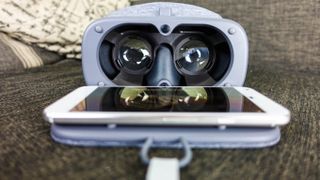
However, there's a big difference between the two smartphones, as the Google Pixel is limited to a 1080p Full HD display.
The 5-inch Google Pixel screen looks fine general use, but up close – two inches from your face – will really bring out all of the individual pixels.
The 5.5-inch Google Pixel XL has a Quad HD display and looks better, but it still presents a noticeable screen door effect; just one that's slightly less exaggerated.
Mobile VR really makes the case for 4K phone displays, with a higher resolution that'll be able to meet the needs of pixel-dense virtual reality, hopefully in 2017.
With either phone, our expensive Pixel phone felt secure every time we fastened the top latch, even if the Google XL looks exposed and vulnerable. Both phones fit just fine.
Remote control
- Comes with a tiny remote control
- Motion detection adds to gameplay
- Slides into the headset for easy carrying
Google Daydream VR comes with a small remote control, and it makes the 360 degree games all the more immersive from the get-go.
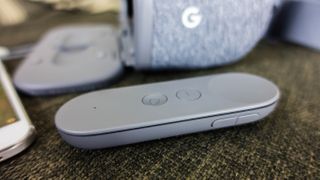
Connected via Bluetooth without any settings menu fiddling required, this remote has two buttons, a volume rocker and a clickable top trackpad.
It's also motion controlled, so everything from adventure games to racing games have you steer characters and go karts with by tilting the remote.
Casting spells in the Harry Potter-like 'Fantastic Beasts' felt natural, even if the experience itself is rather boring. Your magical wand makes it worth trying out.
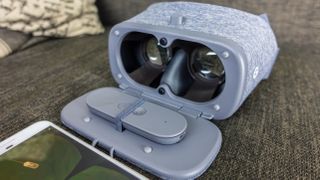
When you're done, the remote neatly tucks away inside the VR headset via an internal strap. Despite the remote's small size, you actually might not lose it.
With the Samsung Gear VR, you can always invest in a third-party controller, but so many people don't do it right away – or at all. Google got this right.
Current page: Introduction, design and remote control
Next Page Games, interface and performanceMost Popular






